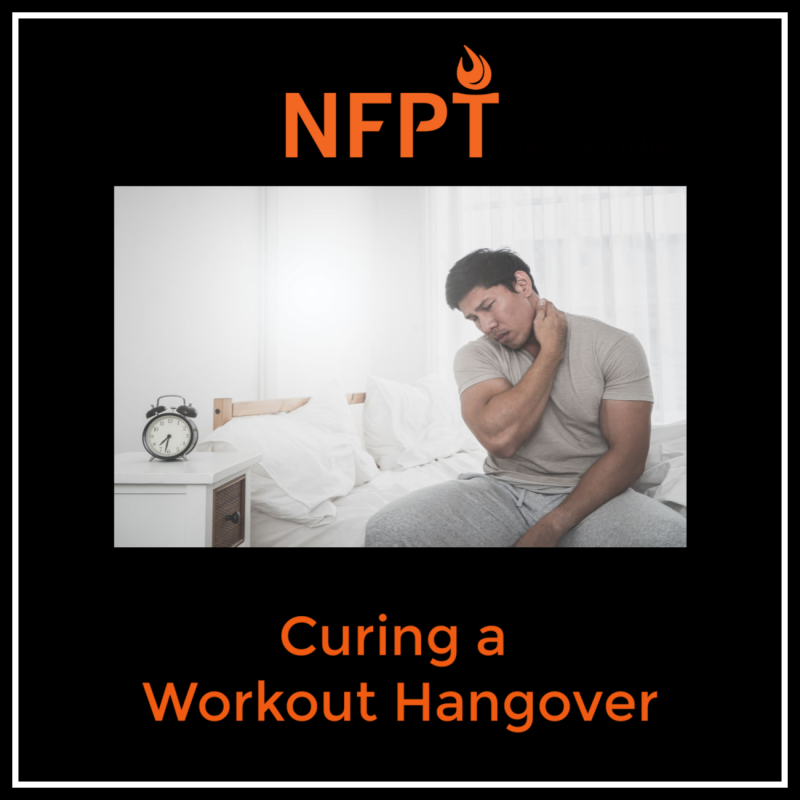
Have clients ever complained of experiencing unusual and daunting exhaustion after several intense sessions at the gym? In addition to a cascade of other physiological processes, he or she may have fallen victim to an all-too-common “workout hangover.”
Overtraining = Workout Hangover
What does a “workout hangover” feel like? Not totally unlike the more commonly experienced alcohol-induced version, extreme fatigue rears its ugly head, rendering it impossible to return to the gym the next day. Injuries and sore muscles take longer to heal, often necessitating 3 – 4 days’ worth of setback in meeting strength/muscle/endurance goals.
Why does this situation occur? A cumulative effect of poor workout habits will, over time, take its toll on the body. Training too heavy, or too often attempting heavy max rep lifts, can cause the problem; marathon runners and ultra-marathon devotees often experience such hangovers in the midst of training for an upcoming event. Cortisol levels spike, negating optimal gains in the gym as the body fights constant fatigue and erodes at hard-earned lean muscle mass. Avid bodybuilders and strength-training enthusiasts might experience these ill effects, especially when workouts shift from “dedicated” to “obsessive”.
Putting Too Much “Head In The Game”
Training “on the nerve” is a practice espoused by Christian Thibaudeau, a leader in the training business for the last 16 years and owner of Thibarmy.com. He has been “Head Strength Coach” for the Central Institute for Human Performance, the official center of the St. Louis Blues (recent Stanley Cup champions and my hometown hockey team). “On the nerve” refers to the mindset in which many lifters put themselves moments prior to a difficult lift or set: the heavy-duty psyching up.
In order to reduce workout hangover, experts advise athletes to minimize the number of maximally heavy lifts necessitating a major psychological prep session. This does not imply that a great deal of concentration isn’t involved; such a task should demand 100% of the lifter’s focus. However, reaching a frenzied emotional state before attempting heavy sets places undue stress upon the adrenal glands, well in excess of the amount naturally brought on by lifts using lesser weights. This, in turn, exacerbates the sympathetic nervous system as well as the parasympathetic nervous system, the one primarily responsible for aiding in recovery.
A Different Mindset
Most of the highly successful professional lifters approach the weightlifting equipment in a Zen-like state of concentration. They adhere to the belief that moving the heaviest weights should require focus and concentration, nothing more. When discussing the importance of recovery with an overzealous client, trainers may choose to take a few extra minutes at the conclusion of a session to ensure that the individual understands the difference between localized recovery (actually occurring at the muscular level), and recovery at the systemic level (the various nervous systems). Systemic recovery allows growth to occur. Suffering from workout hangover indicates the imminent need for such recovery before progress can continue.
Lessening The Load
As dedicated lifters, we often overlook the fact that the smallest percentage of our training year should be spent going heavy, or pushing weights over 90% of a one-rep max range. Many clients want to push progressively more weight too soon or too often, and our advice may seem to fall on deaf ears.
The fact remains that most highly-regarded powerlifting methods worldwide tend towards volumized sets that fall between 68-72% of the one- rep max. Studies show that lower intensity loads produce an amount of hypertrophy equal to those observed when using higher intensity loads, without the negative effects on the recovery curve. While training all-out and hard-core seems required at times, regular sessions of consistently “good” workouts benefit the body much more than the weekend warrior mentality of overdoing once a week. Such a practice leads to subpar physical performance, often necessitating even more rest days.
Somatic Listening
Pay attention to the body’s cues. Check in with your clients regarding adequate hours of sleep and on-point nutrition: if they claim success in both arenas yet consistently lack energy when training with you, the strong possibility of a workout hangover from the day before deserves attention. Gently suggest that instead of masking fatigue with stimulants and fighting through, rest can help more than anything else.
Relay to your clients the other benefits of restorative personal time to help them embrace this recovery mindset. Oxytocin, often referred to as the “love hormone”, can reduce stress and anxiety, keeping cortisol within a normal range. We all know this feeling, the one generated during physical or emotional bonding, either with a close friend, loved one, or even a beloved pet. Tuning into a comedy show or a funny movie can evoke this cortisol-mitigating hormone. Release of endorphins and growth hormone often accompany oxytocin in the bloodstream, improving the immune system response and promoting muscle growth.
The Hardship of the Hangover
In a previous article on overtraining, I highlighted not only excessive exercise as a key player but also insufficient recovery practices. Well-meaning, goal-oriented fitness enthusiasts spend a quarter of their typical workouts going “too hard,” then paying the price in the form of workout injuries and increased recovery time.
According to a new study, as many as 55% of individuals polled have at some point suffered a workout hangover resulting in a forced, unplanned rest day or two. Almost a third reported the need to pass on social outings with friends, attending parties, even canceling dates due to such hangovers.
Why invest so much mental and physical energy designing and executing the taxing strength training paradigm, only to “cut and run” without a plan following the workout? Dr. Aaron Hinde, co-founder of LIFEAID Bev Co., explains the importance of what happens after a workout and how we can potentially mitigate the chances of a workout hangover: “Proper workout and exercise techniques go hand in hand with post-workout recovery. By helping to improve the speed and efficiency of recovery, one can directly help optimize their overall fitness in a whole new way by increasing strength, endurance… you name it.”
He further emphasizes his point by saying, “So much emphasis has been placed on what you consume or drink before a workout, when in actuality it’s what your body needs to help it recover afterward that makes the real difference.”
Dr. Clare Morrison, GP and Medical Advisor at Medexpress, offers an interesting perspective on the physiology of an intense training session. “Firstly, strenuous exercise causes blood to be diverted away from the digestive system, to the muscles, heart, and lungs. ‘If you eat a rich meal shortly before exercise, it won’t be digested properly, potentially causing nausea, vomiting, and diarrhea. In addition, exercise uses up glucose and glycogen stores, leading to nausea, headaches, and shakiness.” The dilation of blood vessels during exercise, and the additional fluid and salt loss in the form of sweat, can trigger a precipitous drop in blood pressure following a heavy exercise session, bringing on light-headedness and weakness.
Healing the Hangover
What do professionals suggest as the best way to deal with workout hangovers? Not surprisingly, recovery involves rest and proper hydration and nutrition. “Do drink sufficient water to quench your thirst, but remember that drinking too much water, without eating a little salt, can make your salt levels fall too low,’” says Dr Morrison. “This will cause confusion, headaches, cramps, and nausea. Add a little salt to your food, perhaps in the form of crackers, salted nuts, or broth.”
She also reminds us – and we might wish to remind our clients – “Eat some unrefined carbs to top up glycogen stores, and lean protein to help repair tired muscles. For example, a good post-workout meal would be whole-grain toast with scrambled eggs, or tuna and brown rice. Avoid alcohol and caffeine, which could make you more dehydrated and/or upset your stomach.”
As you have now learned, workouts can either enhance your health and well-being, or knock your progress in a backward direction. Well-designed training sessions guarantee that your clients build strength and muscle mass. By reminding them and encouraging them to spend their non-training days at the gym wisely, trainers can ensure that each session with a professional will propel them in the right direction, with a minimum of recovery time.
References:
lornemarrfitafter45.ca/christian-thibaudeau/
www.t-nation.com/training/7-ways-to-cure-the-workout-hangover
nypost.com/2019/05/21/more-than-half-of-americans-have-suffered-a-workout-hangover/
www.dailymail.co.uk/femail/article-7379113/Doctor-reveals-workout-leave-feeling-nauseous-anxious-beat-it.html
https://www.dailymail.co.uk/femail/article-7379113/Doctor-reveals-workout-leave-feeling-nauseous-anxious-beat-it.htmlhttps://www.dailymail.co.uk/femail/article-7379113/Doctor-reveals-workout-leave-feeling-nauseous-anxious-beat-it.html
nypost.com/2019/05/21/more-than-half-of-americans-have-suffered-a-wor







